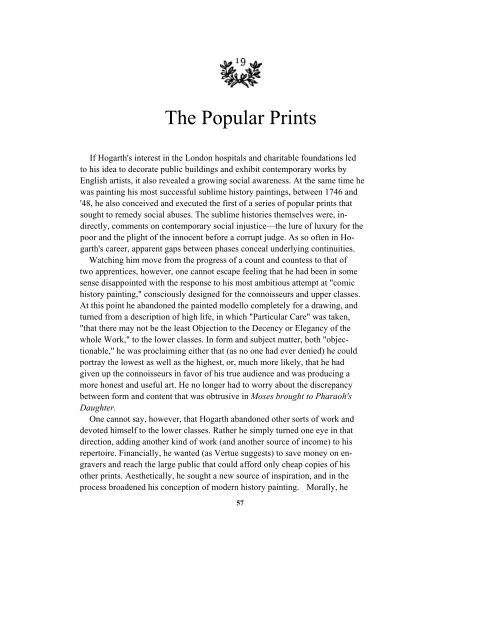Create successful ePaper yourself
Turn your PDF publications into a flip-book with our unique Google optimized e-Paper software.
The Popular Prints<br />
If <strong>Hogarth</strong>'s interest in the London hospitals <strong>and</strong> charitable foundations led<br />
to his idea to decorate public buildings <strong>and</strong> exhibit contemporary works by<br />
English artists, it also revealed a growing social awareness. At the same time he<br />
was painting his most successful sublime history paintings, between 1746 <strong>and</strong><br />
'48, he also conceived <strong>and</strong> executed the first of a series of popular prints that<br />
sought to remedy social abuses. The sublime histories themselves were, in-<br />
directly, comments on contemporary social injustice—the lure of luxury for the<br />
poor <strong>and</strong> the plight of the innocent before a corrupt judge. As so often in Ho-<br />
garth's career, apparent gaps between phases conceal underlying continuities.<br />
Watching him move from the progress of a count <strong>and</strong> countess to that of<br />
two apprentices, however, one cannot escape feeling that he had been in some<br />
sense disappointed with the response to his most ambitious attempt at "comic<br />
history painting," consciously designed for the connoisseurs <strong>and</strong> upper classes.<br />
At this point he ab<strong>and</strong>oned the painted modello completely for a drawing, <strong>and</strong><br />
turned from a description of high life, in which "Particular Care" was taken,<br />
"that there may not be the least Objection to the Decency or Elegancy of the<br />
whole Work," to the lower classes. In form <strong>and</strong> subject matter, both "objec-<br />
tionable," he was proclaiming either that (as no one had ever denied) he could<br />
portray the lowest as well as the highest, or, much more likely, that he had<br />
given up the connoisseurs in favor of his true audience <strong>and</strong> was producing a<br />
more honest <strong>and</strong> useful art. He no longer had to worry about the discrepancy<br />
between form <strong>and</strong> content that was obtrusive in Moses brought to Pharaoh's<br />
Daughter.<br />
One cannot say, however, that <strong>Hogarth</strong> ab<strong>and</strong>oned other sorts of work <strong>and</strong><br />
devoted himself to the lower classes. Rather he simply turned one eye in that<br />
direction, adding another kind of work (<strong>and</strong> another source of income) to his<br />
repertoire. Financially, he wanted (as Vertue suggests) to save money on en-<br />
gravers <strong>and</strong> reach the large public that could afford only cheap copies of his<br />
other prints. Aesthetically, he sought a new source of inspiration, <strong>and</strong> in the<br />
process broadened his conception of modern history painting. Morally, he<br />
57
















